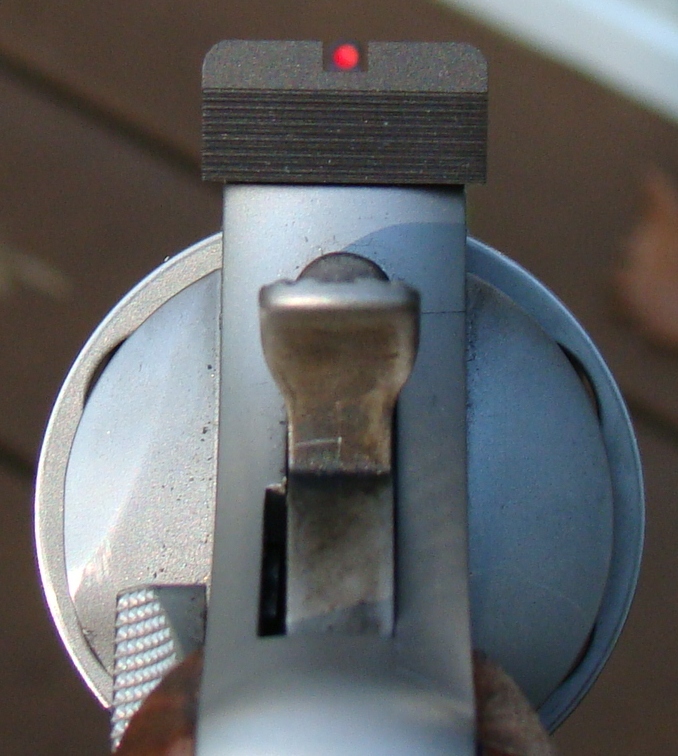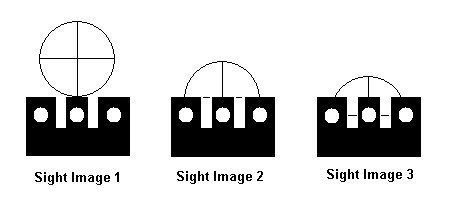A question that pops up in my inbox occassionally is “What kind of sights do you like for your guns?” Next to grips, sights are probably the most personal aspect of a firearm, as most modern guns have nearly limitless options to what kind of sight picture you can hang on them. Generally speaking, I like my sights to have black rear posts (no dots, no nothing) and some kind of high visibility front post, either a white dot, a tritium insert, gold bead, or a fiber optic front.  A good example of what I like is the sight picture on my S&W 625, which features a Bowen Rough Country rear sight and a HiViz fiber optic.
A good example of what I like is the sight picture on my S&W 625, which features a Bowen Rough Country rear sight and a HiViz fiber optic.
The reason I like this particular sight picture is that over the years I’ve become a “dot shooter”. Take a look at the image below, borrowed from Pistol-Training.Com. In the image you have three distinct sight pictures, the first is what’s commonly called the 6 o’clock hold, the second would be “point of aim point of impact” and the third is “floating the dot” or “driving the dot” or whatever you’d like to call it.
 The sight picture that I use, albeit with a single dot on the front post is sight picture number 3. I cover where I want the bullet to go with the dot, and assuming my gun is sighted in correctly that’s where it goes when I pull the trigger. I started using this when I started shooting a lot of IDPA and Steel Challenge; with the high visibility fiber optic front posts I use, I found it was quicker to simply pick up the dot and hammer the target. As long as the front post is roughly aligned inside the rear posts and covering the -0 zone of an IDPA target, it’s faster for me anyway than using a traditional Point of Impact hold.
The sight picture that I use, albeit with a single dot on the front post is sight picture number 3. I cover where I want the bullet to go with the dot, and assuming my gun is sighted in correctly that’s where it goes when I pull the trigger. I started using this when I started shooting a lot of IDPA and Steel Challenge; with the high visibility fiber optic front posts I use, I found it was quicker to simply pick up the dot and hammer the target. As long as the front post is roughly aligned inside the rear posts and covering the -0 zone of an IDPA target, it’s faster for me anyway than using a traditional Point of Impact hold.
This carries over to my “defensive” guns, as well. Any gun that I use for concealed carry, 3-dot sights or single dot I’m going to use this particular hold for them. The last time I shot a gun with 3-dot sights (a Beretta 92FS) this was the hold I used, and it worked just fine.
The caveat here though is “what works for me may not work for you”. Just because I use black rear posts and a high contrast front sight post doesn’t mean that this is the perfect or ideal set up. Some guys like all-black posts, some people like three dot posts, etc. The point is to try different things until you find something that works well for you and helps you get fast hits on target. I will say one thing in defense of the “float the dot” method I use – if you have night sights on your gun at 2am when the balloon goes up there is a good chance all you’ll be able to see are the dots on the sights.
I’ve been trying to drive the dot with my pistols, but then I always have a mental gear grinding experience as I switch to a rifle. On my rifles, mostly AR types, there is no dot so I’m back to “pumpkin on post.” Which was reinforced at an Appleseed and seems to be the only reasonable way to shoot a rifle accurately.
The answer to this is probably “practice.”
Put a red dot optic on your rifle. 🙂
I’m only sort of kidding, actually – a good red dot optic for your rifle would help make the transition from “driving the dot” on a pistol to a rifle pretty much the same thing.
Alternatively, put a dot in your front sight post. There are a few out there (my search for “ar-15 fiber optic post” got 90K hits). I’m in no position to recommend one over another, but TruGlo, HiViz, and others make ’em. If my AR had irons, I’d probably look into putting one in.
I’ve never tried “driving the dot;” but I think I’ll give it a go with my pistol (same sight setup as Caleb’s photo).
For whatever reason, it always felt more intuitive to me. “Put the dot on what needs shot”, aside from being grammatically appalling but rhythmically humorous also just seems to make sense to my reptile hind brain.
Your point makes a lot of sense. I really do like dot optics, and wish the EOTech on my AR didn’t belong to a friend who’s moving away (and wants it back). I never thought of applying the same mode of thought to iron sights, but it does strike a chord.
My logic for POA/POI shooting was that I have a much more precise sight alignment if I’m aligning the tops of the post/blade together and then putting that line directly over my target, simply because the machined edges of those pieces of steel are sharp in my vision and consistent. I’m not trying to put the dot (which is somewhere in the middle of the post — and when I say “somewhere” I mean that it’s not exactly consistent, especially if you installed the fiber yourself and don’t have a perfectly-centered and -circular blob on the end) exactly on target, when I can’t even see the target through the post.
All that said, I think that dot-on-target instead of edge-on-target will shift POI only slightly, except at long distances of course, and will be a hell of a lot faster — assuming that you don’t go into overdrive and line up the dot whilst forgetting to align the front/rear sights! (This was my main enemy when I first switched from all-black to front-fiber.)
But hey — I’m just a C-class shooter. I’ve got a long way to go, and I’m willing to try new things to see if they work for me. (I’m a mathematician — I’ve ingrained the idea of trying something new and accepting wholeheartedly if it works and otherwise rejecting it and moving on without remorse.)
I DO have an XPS3-0 on one of the ARs. 😉
But I’m also a proponent of learning to use the defaults. If I gotta use somebody else’s AR before that zombie makes it up the hill I’d like to know I can make that head shot!
Yeah, yeah. How do I know how they sighted it in? Just work with me here.
In my first IDPA match, they shut off the lights for the last stage and made you shoot with a flashlight. I have to say that the night sights made it a lot easier to get a fast sight picture while I had the target illuminated. Granted, the it might be just as fast with fiber optic front sights. But I’ve never used them, so I have no idea on that one.
On the other hand, the night sights on my Glock will show through a lot of my summer weight button-downs in the dark. The ones on my 1911 are set deeper, so they don’t have as much issue.
Caleb, that’s a fantastic post! I never thought of using that type of sight picture. I’ve always preferred a wide rear, narrow front all-black sight picture, but I’ve always shot for the top edge of the front sight.
I am going to give this try. Thanks for posting it!
I’ve never understood the Six O’Clock Sight Hold.
Over time, I’ve come to use the POA / POI sight picture. In order to make the 6OSH work, I’ve always had to jigger with sight adjustment more than I like to; if I don’t I put the bullet at 6 o’clock, usually about 2″ below where I want it – it’s just never felt natural to me. And yet in about half the classes I’ve ever had (from Boy Scouts onward), they’ve taught the 6OSH. I’ve consistently seen new shooters who’ve learned it place their shots low, so I don’t get the point of this approach at all.
Can anyone explain this to me?
Curtis:
It’s easier to see with a circular target.
Sight picture #2, if you don’t have anything lateral to the bull, is almost impossible to tell when you’ve got the height perfect.
Using the 6 o’clock hold (usually I see that as a 6 o clock on the bullseye, not the whole target), lets you see the bottom of the circle and use that as the reference.
For instance, in the CMP matches I’ve shot (2 of them, so I won’t claim to have a canonical understanding of the targets), the width of the Garand front sight exactly subtends the black. So line that up for the lateral, put it at 6 o’clock for the vertical, and there you go.
Have you tried a gold-bead partridge sight? I picked up a S&W 625 at their booth at the NRA show and was blown away by how easily I could pick up that front sight – and I have old man eyes!
I dig the gold bead sights – I’m seriously considering throwing those on my Bianchi Cup production revolver.